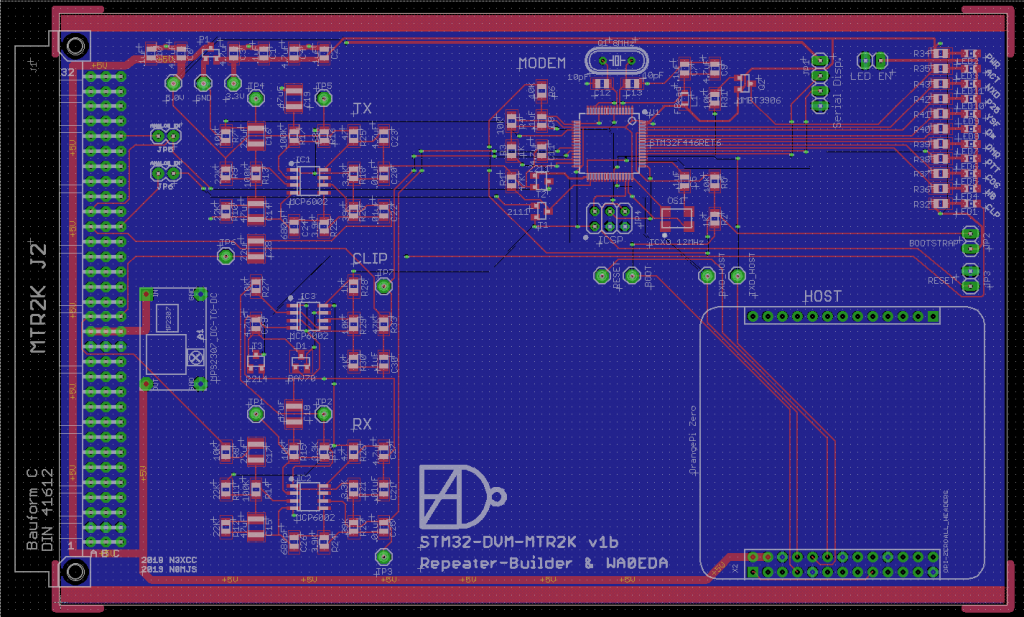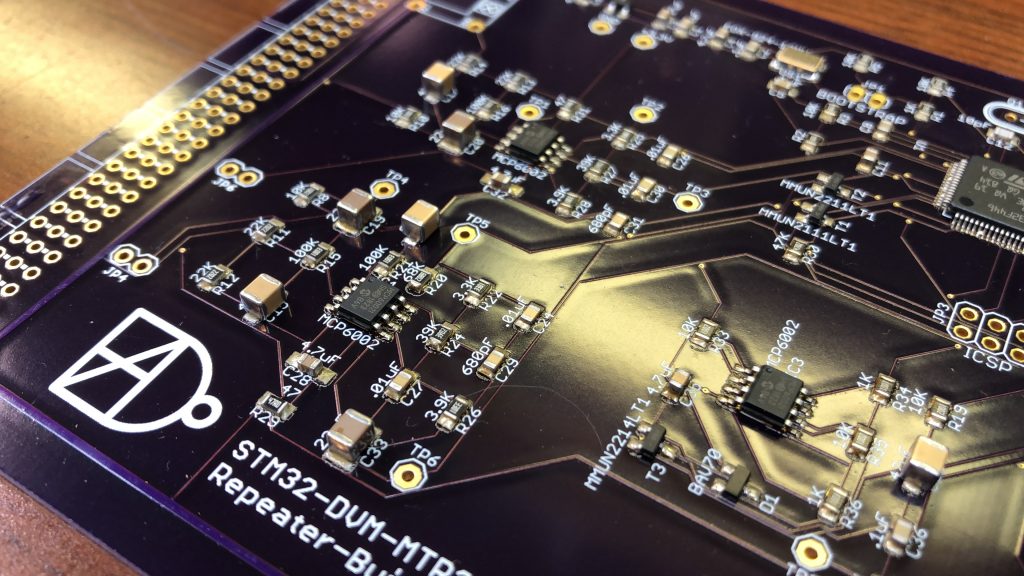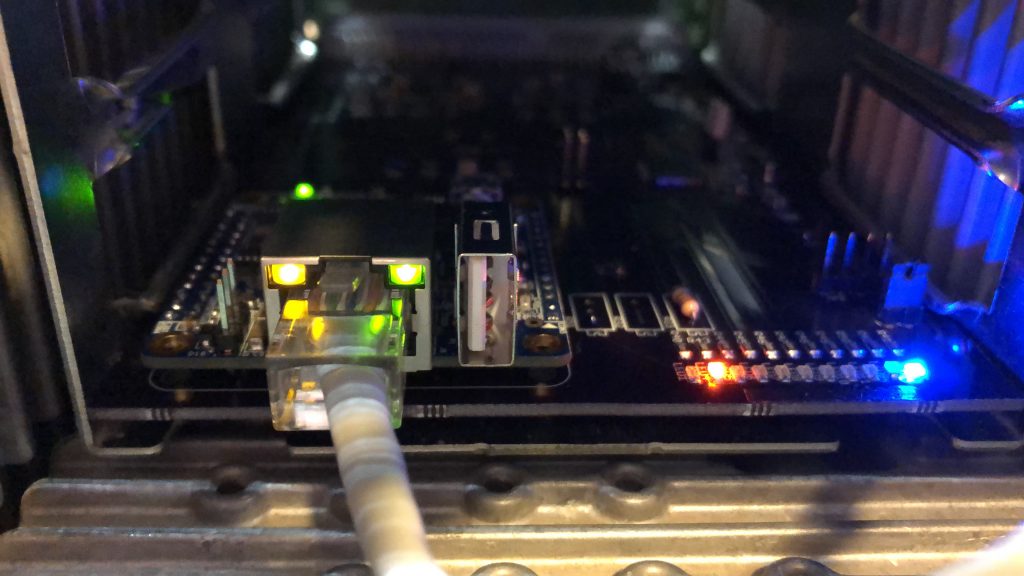We at KS-DMR really like to do things right. We’re all about clean installs and top-quality equipment. Two of our favorite things are the Repeater-Builder STM32-DVM MMDVM Modem and the Motorola MTR2000 repeater.

The MTR2000 is a really awesome package. It packs a lot of purpose-built, public-safety grade repeater into a small amount (just 3U) of rack space. But hanging a cable off of the back to go to a Raspberry PI + PiHat or a separate rack mount server adds to the space and clutter. It’s just not as clean, and there are more wires to snag… more chances for something to go wrong.
The Repeater-Builder STM32-DVM is, we think, the best MMDVM Modem board out there. It includes a powerful micro controller, lots of test points, a well-tested filter design, nice diagnostic LEDs, and a handy ‘clip’ light for easy RX level adjustment.
We’d long talked about trying to stuff the Pi+PiHat STM32-DVM into the MTR2000’s card cage, but there were issues. It really didn’t fit well, mounting was challenging, and the package used more current than Motorola rated for the supply to the card cage. We didn’t want to accept no for an answer, so we decided to come up with an even more elegant solution!

Our solution is a new PCB to plug directly into the card cage, just like a Motorola option board, but incorporating the STM32-DVM design. There is a smaller, more power efficient SBC (single board computer) to handle the MMDVMHost functions, since a Pi is both too big, and uses too much current. The result is the STM32-DVM-MTR2K from WA0EDA.
K0USY Group and WA0EDA Club are sister clubs, K0USY Group is the production arm, and was founded in memory of Jack C. Buffington, K0USY, with WA0EDA Club being the R&D “Skunkworks”, in memory of Rolland D. “Slim” Cummings, WA0EDA.
– Cort Buffington, N0MJS on the formation of WA0EDA Club and K0USY Group
We’ve made it through design and testing and are ready to introduce this new accessory board into our network. The board is intended to plug into the Option 1 or 2 slot of the MTR2000. By optimizing the circuit for the MTR2000, the pots were removed, along with a few other unnecessary components – all adjustments are completed with the MTR2000’s internal soft-pots and RSS! And, best of all, a much more power efficient OrangePi Zero is included to run the MMDVMHost software, or PiStar, if that’s your thing.

But we don’t intend to keep this innovation to ourselves. In future this board will be available directly from the developer, K0USY Group’s Cort Buffington (N0MJS). It is possible that the board may be offered through a partnership with Repeater-Builder and Scott Zimmerman, N3XCC. The 2nd prototype PCB and production candidate will be deployed next week, so it will be a short while until boards will be available to the public.

For more information contact Cort Buffington, N0MJS, at n0mjs@me.com. Cort is the Trustee of the WA0EDA Club, and the chief engineer for K0USY Group; he is also known for his work as the author of the DMRlink, HBlink and dmr_utils software packages used by independent DMR networks around the globe.
This article is part one of a three part series on the STM32-DVM-MTR2K. Click here to read part two.

16 comments on “Introducing The STM32-DVM-MTR2K”
Reid, N0RC
April 12, 2019 at 5:54 amThis is really impressive. Have you done any measurements for radiated emissions from your design?
Cort Buffington
April 12, 2019 at 9:57 amI do not have the necessary equipment or expertise to do the kind of compliance testing that would be done for a commercial product in an industrial setting. But this is the land I’ve always lived in, so I have to rely on measurements I can make and good design practices. This is exactly why I used a commercially available SBC that included the Ethernet magnetics and jack also. That board is the primary concern for emissions issues – including the often overlooked Ethernet interface. That doesn’t mean it’s done right, but choosing a popular, mainstream SBC seems the most prudent action. The microcontroller is of considerably less concern with an external oscillator of 8MHz and an internal multiplier. There are no signs of concern with the 1st prototype, and I tightened up the area around the micro controller significantly on the 2nd run for good measure – the 1st was spaced out more to make assembly and troubleshooting easier.
Josh
April 12, 2019 at 12:54 pmnice work – n0eg
Jerry Dixon, KC0KW
April 12, 2019 at 11:03 pmGreat Idea, excellent execution, wonderful work…
Gavin
April 13, 2019 at 3:08 pmWA0EDA Skunkworks for the win.
Mike Ess
May 18, 2019 at 8:16 pmAny chance this will also work with AllStarlink on the analog side?
Cort Buffington
May 19, 2019 at 11:44 amIf you mean is AllStarLink baked in? No. If you want to externally interface AllStarLink to a station using the STM32-DVM-MTR2K, that’d be entirely possible. See the 3rd article on coexistence with analog to get some more ideas. That article was written around using the built-in controller, but the same logic would apply.
Mike Ess
May 21, 2019 at 8:33 amCort, Thanks! This looks like the solution that I was looking for. If you need another alpha/beta tester, I would be glad to put this in on our site. I have been debating putting our spare DR1X up as ours has crapped out AGAIN.
Cort Buffington
May 21, 2019 at 9:13 amI’m out of the alpha/beta testing stage. It’s 100% in production.
Mike Ess
May 21, 2019 at 10:25 amAwesome. Need to get our Machine back on the air, and adding More Digital modes would be great. Is there a link to where I can purchase one?
Cort Buffington
May 22, 2019 at 11:11 pmIt’s not listed on the site yet, but contact Scott Zimmerman through http://www.repeater-builder.com/products/stm32-dvm.html
I’m building them for KS-DMR and affiliates, and a few friends. If Scott cannot accommodate you, get with me directly.
Gervais ve2ckn
May 22, 2019 at 9:39 pmhi,
any chance that it could be installed on an old MSR2000??
73/s
gervais,ve2ckn
Cort Buffington
May 22, 2019 at 11:08 pmThe only thing common about the MSR2000 and MTR2000 card-cages is that they both have them. Signals, voltages, form-factor, pin spacing, number of pins… all different.
I recommend the Repeater-Builder STM32-DVM for the MTR2000. I’ve interfaced one before, went real easily, and there’s plenty of room in the station for it.
Mike Ess
May 23, 2019 at 10:57 pmDoes the board include a Orange Pi zero when it comes from Scott or will one need to be purchased separately?
Cort Buffington
May 23, 2019 at 11:12 pmI build some of mine with the OrangePi Zero and some with the NanoPi NEO. I believe Scott is using the NanoPi NEO exclusively – but whether or not he includes it would be a question to ask him, not me. I do not speak for Scott or Repeater-Builder.
Dave
May 25, 2019 at 12:15 pmI’ll need to pick up one of those for sure